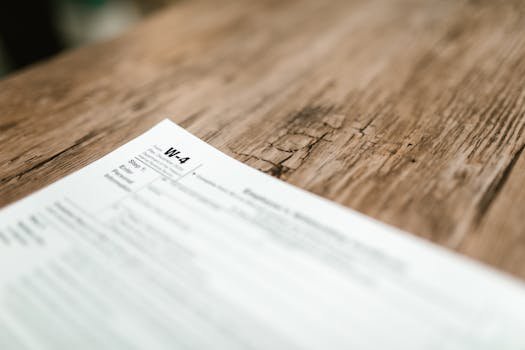If you sell services to U.S. clients through your own company—not as a private individual—your counterpart will likely ask for Form W-8BEN-E. It’s longer than the W-8BEN and sprinkled with acronyms (FATCA, NFFE, GIIN), but most one-person companies only need three things: the right entity classification, a clean treaty claim (if any), and a short statement about substantial U.S. owners (usually “none”). This guide turns jargon into checkboxes—using a recurring example: a single-member company working from Bali with U.S. clients.
Introduction: When the W-8BEN isn’t enough
For non-U.S. persons, W-8BEN (individual) is the familiar form used to certify foreign status and claim treaty benefits on investment income (like dividends). But when you’re invoicing as a company—even a single-member company—you are no longer an individual payee. Your client’s accounts payable team now needs the entity version: W-8BEN-E. Why? Because U.S. withholding rules split into two tracks:
- Chapter 3 (treaty/withholding) — ensures the right tax is withheld on payments to foreign persons.
- Chapter 4 (FATCA) — classifies foreign entities so payers can report/pay correctly.
W-8BEN-E covers both tracks for entities. That’s why it’s longer. The good news: if you’re a one-person operating company that provides services (design, coding, consulting) from abroad, you’re almost certainly a foreign NFFE (non-financial foreign entity), not a bank, fund, or other “financial institution.” That means no GIIN is needed, and the FATCA section becomes a few targeted checkboxes. The hard part isn’t the form—it’s picking the right boxes with confidence, keeping your address/registration in sync with your invoices, and avoiding the traps (like using W-8BEN-E for a U.S. LLC, which typically needs a W-9 instead). We’ll walk through it all, step-by-step, with plain English and concrete examples.
What is the W-8BEN-E and who needs it?
Entities vs individuals
W-8BEN is for individuals. W-8BEN-E is for foreign entities (companies, partnerships, trusts). If you invoice as “Jane Smith”, you’ll be asked for W-8BEN. If you invoice as “Bali Code Lab OÜ” (Estonian company), W-8BEN-E is correct. The payer needs to know (a) what you are for Chapter 4 (FATCA)—financial institution or not, active or passive—and (b) whether you’re eligible for treaty benefits for Chapter 3 withholding on certain U.S.-source income.
Key sanity check: If your entity is incorporated in the U.S. (e.g., a Delaware or Wyoming LLC/corp), it’s a U.S. person for tax form purposes; your client will expect Form W-9, not W-8. Many nomads trip on this: U.S. entity ≠ foreign entity. W-8 forms are for non-U.S..
Common nomad scenarios requiring W-8BEN-E
- Foreign single-member company (Estonia OÜ, UK Ltd, Cyprus Ltd, etc.) billing U.S. clients for services.
- Foreign partnership (two freelancers sharing a foreign company) with U.S. clients.
- Foreign contractor entity paid by a U.S. marketplace/platform under a B2B agreement.
- Hybrid entity cases (rare for one-person shops): your entity is treated differently across jurisdictions and you’re asked to claim treaty benefits as an entity.
If you bill as a person (no company), use W-8BEN. If you bill through a U.S. entity, use W-9. If you bill through a foreign entity, use W-8BEN-E.
Single-member LLCs, freelance companies, contractors
Keep the jurisdictions straight:
- U.S. single-member LLC owned by a non-U.S. person: for U.S. payers, this is a U.S. entity—expect a W-9 (and separate U.S. filings may apply).
- Foreign single-member company (e.g., Estonia OÜ, UK Ltd): this is a foreign entity—W-8BEN-E.
- Sole-prop with no company: W-8BEN (individual).
When in doubt, ask: “Where was this entity incorporated?” That single fact usually answers the form question.
See how it hits rates in Reading the 1042-S.
W-8BEN vs W-8BEN-E: key differences
| Feature | W-8BEN (Individual) | W-8BEN-E (Entity) |
|---|---|---|
| Who uses it | Natural persons (non-U.S.) | Foreign entities (non-U.S.) |
| Purpose | Certify foreign status; optional treaty claim | Certify foreign entity status for Chapter 3 & 4; optional treaty claim |
| FATCA classification | Not applicable | Required (NFFE vs FFI, active/passive, etc.) |
| GIIN field | N/A | Only for FFIs (financial institutions). Most one-person shops don’t have/need a GIIN. |
| Complexity | Short | Long (entity types + FATCA status sections) |
| Typical nomad use | Individual freelancer paid directly | One-person company paid for services |
Takeaway: If your company is getting paid, the payer needs your entity status (FATCA) and treaty position (Chapter 3). That’s why the W-8BEN-E exists.
FATCA and Chapter 3/4 basics
What FATCA means for your business entity
FATCA (Foreign Account Tax Compliance Act) is primarily about identifying and reporting payments to foreign entities. It splits the world into FFIs (foreign financial institutions—banks, custodians, certain investment entities) and NFFEs (non-financial foreign entities). Your one-person operating company almost always sits in NFFE land. FATCA asks NFFEs two big questions: (1) Are you active (you actually sell stuff/do services) or passive (mostly holding investments)? (2) Do you have any substantial U.S. owners? If yes, disclose them.
If you’re not an FFI, you do not need to register for a GIIN. Your W-8BEN-E simply certifies you’re an Active NFFE (or Passive NFFE) and lists any U.S. owners if passive.
GIIN numbers explained
A GIIN (Global Intermediary Identification Number) is an ID that certain FFIs obtain by registering with the IRS. It tells payers: “We’re a compliant financial institution.” Most one-person service companies are not FFIs (they’re not banks, brokers, or investment funds). Therefore, no GIIN is needed. If an A/P clerk asks for your GIIN “because the form has a box for it,” politely explain you are an NFFE (non-financial), not a financial institution, so GIIN does not apply.
When you need a GIIN (spoiler: usually you don’t)
You’d need a GIIN if your entity is an FFI or acts like one (certain investment vehicles, custodial institutions, etc.). One-person creative/tech businesses don’t fall here. If you truly run an investment fund, different rules apply—get professional help. Otherwise, skip the GIIN lane.
Entity classification for nomads
Disregarded entities (single-member LLCs)
Two flavors matter:
- U.S. single-member LLC: a U.S. entity disregarded for U.S. tax doesn’t disappear for form purposes. It’s still a U.S. person entity; the payer wants a W-9.
- Foreign single-member company that’s disregarded under your home law: for U.S. withholding, the beneficial owner may be you personally. Some payers may accept W-8BEN from the owner instead of W-8BEN-E from the company. However, many will insist on W-8BEN-E if the contract and invoices are issued by the entity. When in this gray zone, choose the cleaner story: if the entity is on the invoice, provide the entity form and classify it correctly.
Partnerships
If you and a co-founder own a foreign partnership, you’ll provide W-8BEN-E for the partnership and, depending on your FATCA status (often Passive NFFE), disclose any substantial U.S. owners. Some platforms also request look-through documentation. Keep your cap table tight and up to date.
Corporations
A foreign Ltd/Corp/OÜ doing active business typically classifies as an Active NFFE (earning active income, not primarily holding passive investments). This is the most common one-person business case. Treaty claims (if any) depend on where the company is resident under the treaty (usually where it is managed and controlled or incorporated, per treaty wording).
Trusts (rare for nomads)
If your services or IP are held in a foreign trust, the classification depends on the trust’s nature (and whether it’s an FFI). Many operational nomads won’t be here. If you are, get advice—the wrong tick box causes weeks of A/P back-and-forth.
Active vs passive NFFE/FFE classification
What these acronyms actually mean
- FFI: Foreign Financial Institution. Think banks, brokers, certain funds or investment entities.
- NFFE: Non-Financial Foreign Entity (most normal companies).
- Active NFFE: 50%+ of gross income is active (not passive interest/dividends), and 50%+ of assets produce active income. A service company with clients fits here.
- Passive NFFE: primarily passive income/assets (holding company, investment vehicle). If passive, you must disclose substantial U.S. owners (names, addresses, TINs) or certify there are none.
How to determine your classification
Ask: Do we run an operating business? If yes, and your revenue is from services/products, pick Active NFFE and be done. If your entity mainly holds investments (earning interest/dividends/capital gains), you’re likely Passive NFFE and need the U.S. owner disclosure (if any). Only if you are truly in the business of financial intermediation or investment fund activities should you explore FFI categories—and that’s a different conversation.
Filling out the W-8BEN-E: line-by-line guide
We’ll use Bali Code Lab OÜ (a one-person Estonian company selling design/dev services to U.S. clients) as the running example.
Part I: Identification
- Line 1 (Name of organization): Bali Code Lab OÜ.
- Line 2 (Country of incorporation/organization): Estonia.
- Line 3 (Name of disregarded entity): Leave blank unless relevant.
- Line 4 (Chapter 3 status): Corporation (or Partnership, etc., matching your legal form).
- Line 5 (Chapter 4/FATCA status): Active NFFE for an operating services company (or Passive NFFE if you mostly hold investments).
- Address lines: Use your registered office / principal address—the one on your invoices and company registry. Avoid P.O. boxes unless allowed.
- Mailing address: Only if different.
- U.S. TIN / GIIN: Most foreign NFFEs don’t have either; leave GIIN blank unless you are an FFI.
- Foreign TIN: Provide your local company tax number (e.g., Estonian registry/TIN). Many payers now expect a foreign TIN to validate treaty claims and due diligence.
- DOB: Not for entities.
- Check the box to certify you are the beneficial owner (or, if you’re a hybrid entity making a treaty claim, follow your payer’s instructions).
Tip: Make the legal name and address match your invoice header and public registry entry. Consistency reduces compliance questions.
Part III: Claim of tax treaty benefits (entity version)
Complete this only if you’re claiming a reduced rate under an income tax treaty (e.g., on U.S.-source royalties or certain service fees—depends on your facts). You’ll:
- Identify your treaty country (where the company is resident under the treaty).
- Check that you are a resident within the meaning of the treaty.
- Specify the article (the form or your payer’s portal may guide you).
- If required, confirm limitation-on-benefits (LOB) conditions are met (for small, genuinely managed companies, this is often straightforward).
- Provide your foreign TIN.
Note: For pure service income performed outside the U.S., there often isn’t U.S. withholding in the first place (not U.S.-source), so no treaty claim is necessary for that payment stream. Still, some payers ask you to complete Part III as a standard step—follow their workflow and be truthful.
Part XXX: Entity type-specific sections
The W-8BEN-E includes multiple “Part XX…” sections for each FATCA status. Complete only the one(s) matching your Chapter 4 status:
- Active NFFE: complete the Active NFFE part (usually a short certification that your income/assets are active).
- Passive NFFE: complete the Passive NFFE part and include info about any substantial U.S. owners (or certify none).
- FFI categories: only if you’re a financial institution (unlikely for a one-person operating company).
Finally, sign and date (with capacity, e.g., Director). Keep a PDF copy with your client file. Many payers request a new form every 3 years or when facts change.
Substantial U.S. owners and controlling persons
Who needs to be disclosed
If you certify Passive NFFE, you must list any substantial U.S. owners (generally significant direct/indirect U.S. ownership; thresholds vary by structure—corporations commonly >10% vote/value; partnerships often >10% profits/capital; trusts follow different rules). For Active NFFE, this disclosure is typically not required. A typical one-person operating company with a non-U.S. owner has no U.S. owners to disclose—just tick Active NFFE and move on.
Documentation requirements
If the payer asks for a controlling persons addendum (common under bank/KYC rules), be ready with:
- Ownership chart (even if it’s “100% Jane Doe (non-U.S.)”).
- IDs for owners/controllers if requested by compliance/KYC.
- Company registry extract showing directors and share capital.
Don’t over-supply documents; give what’s reasonably requested to establish status and ownership.
Common W-8BEN-E mistakes for one-person shops
- Sending W-8BEN-E for a U.S. LLC. If you incorporated in the U.S., the payer wants W-9, not a W-8.
- Choosing FFI/financial statuses by accident. If you’re not a bank, broker, or fund, you are almost certainly NFFE.
- Claiming treaty benefits the entity can’t support. Treaty residence belongs to the entity, not the shareholder’s passport country. Make sure management/registration facts support the treaty country you claim.
- Leaving FATCA status blank. Chapter 4 must be completed (Active NFFE vs Passive NFFE).
- Ignoring substantial U.S. owner disclosure when Passive NFFE applies. If there are U.S. owners above the threshold, disclose them (or restructure ownership before engaging U.S. payers).
- Mismatched addresses. Your W-8BEN-E, invoices, and company registry should align.
- Letting the form go stale. Many payers treat W-8s as valid until the last day of the third calendar year after signing or until a change in circumstances. Update promptly if your facts change (address, country of residence, ownership).
When to seek professional help
- You operate through multiple entities (holding + operating) and get U.S.-source royalties or license fees.
- You think you’re a hybrid entity for treaty purposes, or your advisors disagree about beneficial owner status.
- You have U.S. co-owners and you’re unsure if you’re Active vs Passive NFFE.
- A payer insists you’re an FFI or demands a GIIN and you don’t see why.
- You expect U.S. withholding on certain payments and want to structure it cleanly under a treaty.
One or two hours of specialist time can prevent weeks of back-and-forth with compliance departments—and keep your invoices flowing.
Conclusion: More complex than W-8BEN, but manageable
W-8BEN-E looks intimidating, but for a one-person foreign company that sells services, it boils down to five steps:
- Confirm you’re a foreign entity (not a U.S. entity).
- Pick the right Chapter 4 status: Active NFFE for operating businesses; Passive NFFE only if you’re truly an investment/holding vehicle.
- GIIN: not applicable for NFFEs.
- Treaty claim (Part III) only if relevant to the payment type and supported by the company’s residency under the treaty.
- Sign, date, save, and refresh when your facts change or every three years.
Keep your registry extract, foreign TIN, and address consistent with your invoices. For edge cases (hybrids, funds, U.S. co-owners), call a pro. Otherwise, you’ve got this.
Decision Tree — “Do I need W-8BEN or W-8BEN-E?”
Are you invoicing as a company/entity?
├─ No → You are an individual → Use W-8BEN (non-U.S. person).
└─ Yes → Is the entity incorporated in the U.S.?
├─ Yes → U.S. entity → Use W-9 (not a W-8).
└─ No → Foreign entity → Use W-8BEN-E.
└─ Are you a financial institution (bank/broker/fund)?
├─ Yes → You may be an FFI (consider GIIN).
└─ No → You are an NFFE:
├─ Active NFFE (operating business) → No GIIN, no U.S. owner listing.
└─ Passive NFFE (investment/holding) → Disclose substantial U.S. owners (if any).
Quick comparison table (print-friendly)
| Scenario | Form | Chapter 4 status | GIIN? | Treaty claim? |
|---|---|---|---|---|
| Solo freelancer (no company) | W-8BEN | N/A | No | Maybe (depends on income type) |
| Foreign one-person company selling services | W-8BEN-E | Active NFFE | No | Maybe (rare for pure offshore services) |
| Foreign holding/investment company | W-8BEN-E | Passive NFFE | No | Maybe; disclose U.S. owners |
| U.S. LLC/Corp | W-9 | U.S. person | N/A | N/A |
Fix typos/transliterations via Name Mismatches & Other Nightmares; store a signed copy with Records That Travel.



